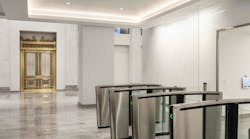The global supply chain continues to experience significant strain caused by the challenges of the COVID-19 pandemic. According to Accenture, 75% of companies felt negative or strongly negative impacts on their business due to supply chain disruption in 2021. Delayed shipments, manufacturing slowdowns and increasing consumer demand are some of the most considerable pressures on logistics operations today, in addition to increasing security threats. With global supply chain issues continuing to persist and security threats increasing, here are four security trends logistics businesses can apply to stay protected.
1. Starting from the Outer Perimeter and Working Inward
Modern logistics organizations require a holistic view of their security landscape. Starting security monitoring at the perimeter of your facility and moving into the parking lot to inside the facility provides a more comprehensive picture and the opportunity to respond to and prevent threats as soon as they occur. When evaluating these areas, consider the following:
Fence Line
● Is the fence intact? Has it been breached?
● Do you have a maintenance schedule to maintain the fence and make repairs if it is damaged?
● Do you regularly inspect the fence line for breaches, damage or tampering?
● Is the perimeter area correctly illuminated for visual surveillance?
● Do you maintain clear landscaping inside and outside the fence line for enhanced visibility and deterrent value?
Building Exterior
● Do exterior doors have secure locking mechanisms?
● Does the parking lot have sufficient lighting for nighttime surveillance?
● Do you have video surveillance or other monitoring to see if unauthorized activity happens after hours?
● Are primary entrances monitored (by people or technology)?
● Are exterior paths and walkways monitored to ensure people’s safety?
Facility Interior
● Do you have security checkpoints inside the building?
● Is your facility required to maintain specific standards to meet regulatory requirements, e.g., the FDA standards for food products?
● Do you have access control policies and procedures for employees, vendors and other visitors?
● Is there appropriate lighting to support effective video surveillance and recording?
● Do you have properly designated walkways to minimize the risk of injury?
By implementing your security review or assessment from the perimeter and working inward, your logistics facility will be more effective in protecting its employees and sensitive data.
2. Evaluating Training and Maintenance Protocols
Organizations that have efficient training and maintenance protocols are better protected, and a facility’s security is only effective if there is a training program and regularly scheduled maintenance to support it. For example, if a refrigerated food storage facility does not properly monitor the temperature levels, perishable food will spoil, which can result in a huge loss in both product and money.
A successful training program will result in efficient security protocols designed for the unique needs of the facility and assets. By ensuring the team learns how to catch problems sooner rather than later, there will be more time to work on a resolution and avoid lost or damaged products.
For instance, warehouses that store and distribute small electronics, such as smartphones and headsets, have a higher likelihood of internal theft, particularly during the holiday season when seasonal staff levels increase. By understanding seasonal trends, the warehouse management team can closely monitor their operations and identify potential loss or theft as early as possible. To mitigate threats like theft, businesses might add security checkpoints and restrict access to other areas of the facility.
Regular maintenance of security equipment is critical to the safety and security of logistics facilities. Even if an organization invests in the latest technology and the best security solutions, without the proper resources to maintain everything, it will not matter. In fact, it is usually more cost effective to start with smaller changes to the security program, such as adding a couple of new security cameras to a legacy surveillance system or redesigning security patrols. Once a facility can keep up with minor changes, then consider implementing bigger upgrades, like event-based monitoring or a security operations center.
3. Adding Video Analytics to Security Cameras
The latest advancements in data analytics have led to ever-more intelligent video surveillance systems. Security camera use in the U.S. has grown dramatically, largely due to the rise of technology, with security camera installations growing around 21 percent - from 70 million to 85 million cameras - between 2018 and 2021, according to the U.S. Bureau of Labor Statistics. This technology can automatically detect unauthorized activity and send an alert to an onsite security officer or a remote security operations center for a response. Organizations can even add video analytics software “on the edge” of their existing cameras instead of buying new cameras, which saves on product purchase, installation and labor costs.
If interested in adding video analytics to the security system, evaluate the current camera system to see if it aligns with current business objectives. It is possible that the facility’s needs have changed since the original cameras were installed, or if the facility already had a camera system, it’s important to assess how they perform.
For example, a logistics company that distributes products regulated by the Customs-Trade Partnership Against Terrorism (CTPAT) must ensure the integrity of all shipments delivered to their warehouse. This includes a seven-point inspection process to make sure no containers have been damaged or tampered with in transit. When cargo comes out of the container, it must be visually tracked from when it enters the warehouse until it is stored. In this case, the logistics company should evaluate camera placements to ensure they meet current regulatory requirements.
Once the camera system has been optimized for operations, video analytics can be added to the cameras. Modern video analytics typically uses artificial intelligence and computer vision to collect and analyze visual data about people, vehicles, objects and events surrounding the business. By constantly learning about the facility, video analytics software can provide valuable insights into operations, such as safety concerns, health and safety compliance, unauthorized behavior, improperly secured areas and more.
Using technology to monitor warehouses and other facilities can improve the efficiency of an organization’s security program and enable companies to focus their resources on other priorities.
4. Improving Access Control
Although access control is one of the most fundamental parts of securing a facility, it is not always simple. Today, most companies collaborate with external vendors, suppliers and other partners that access their facilities on a regular basis. To ensure that only trusted individuals have access to secure areas, a logistics company should segment access lists.
For example, some logistics organizations have an internal fleet of drivers to move tractor-trailers. However, many of these organizations subcontract their transportation needs to a third party. In this case, contracted drivers do not need the same level of access as other employees at the warehouse. Depending on the layout of the warehouse, drivers might not be easily restricted to shipping and receiving areas.
Not every facility was designed with the requirements of modern, high-volume logistics in mind. With the added demand on the supply chain today, warehouses are often rapidly converted for seasonal needs to store overflow products for time-sensitive sales and distribution. More tractor-trailers are parked onsite than before, typically arranged in order to fit as many as possible rather than considering access control and associated potential security threats.
To mitigate the risks to a facility’s security, access control needs to become a priority. Consider how both people and vehicles enter and move around the property. Is there vehicle-specific access or an exterior entrance just for third-party vendors and suppliers? If visitors need to use the restroom, will they have to enter a secured area? Are there clearly designated pedestrian walkways both inside and outside of the facility?
In a recent incident, a third-party logistics provider suffered hundreds of thousands of dollars of loss in a heist orchestrated by several employees who stole a tractor-trailer of cigarettes. A driver entered the facility in the middle of the night, when most employees should not have access and drove the trailer to another location, where it was unloaded. Then the driver brought the trailer back and claimed to have accidentally taken the wrong trailer. In this case, the theft could have been avoided entirely if access control were more specific.
In addition to staffing entrances, gates and other checkpoints with security officers, many modern warehouses now have remote monitoring to oversee access control. Remote monitoring is particularly useful for nighttime surveillance of warehouses that store consumer electronics, cars or other high-value goods. Instead of having one or two security personnel on the night shift, businesses can connect their camera systems to a remote monitoring center, where trained surveillance agents can watch camera feeds, run video analytics and use talk-down audio to engage with trespassers and interrupt a crime in progress.
Logistics companies, or teams, are responsible for overseeing many areas of the supply chain, and security is a critical component. If facilities do not improve their security, they could be impacted by huge costs associated with product loss and damage, injuries to employees and visitors, and significant disruption to their operations.
Ultimately, securing warehoused assets ensures that logistics companies can fulfill commitments to their customers, protecting their reputation and bottom line.
About the authors: Eric Viletto is the Regional Director of Commercial Development at Prosegur Security USA. Having worked in the commercial services industry for more than a decade, Eric has developed a specialized focus on blending a combination of electronic security and uniformed guarding programs. Having served many vertical industries, property types, and customers whose businesses span local, national, and global commerce, Eric brings experience in crafting solutions leveraging multiple programmatic components around the customer’s specific challenge at hand. A
Joseph Murphy is the Senior Vice President at Prosegur Security, managing the growth and brand development of Prosegur’s commercial services division in the United States. With nearly 40 years of contract security services management experience, Joe is a recognized professional in Atlanta’s physical security marketplace. He has worked for notable firms including Borg-Warner Protective Services establishing the Olympic Operations Center for the 1996 Olympic Games in Atlanta. Joe is a long-term member of ASIS International, a past President of the FBI’s InfraGard Program.






